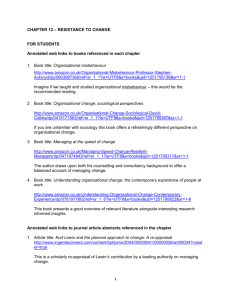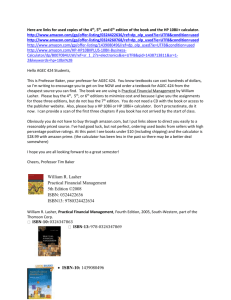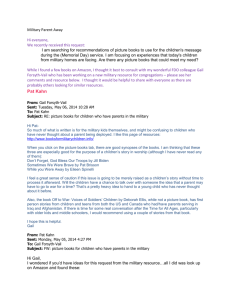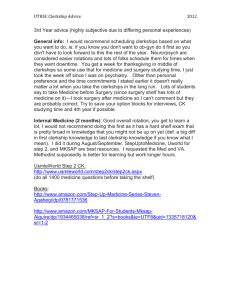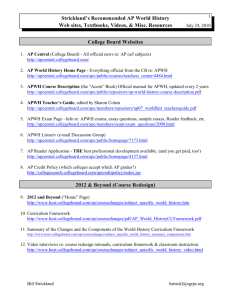Soft Side Syllabus - Upchurch Watson White & Max
advertisement
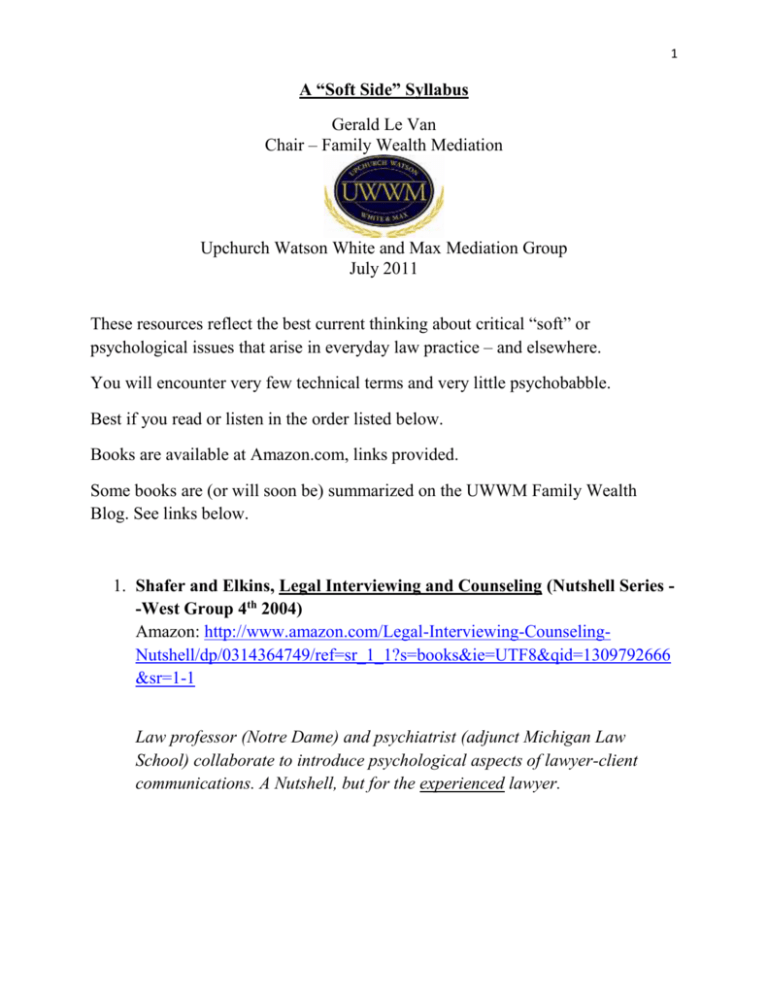
1 A “Soft Side” Syllabus Gerald Le Van Chair – Family Wealth Mediation Upchurch Watson White and Max Mediation Group July 2011 These resources reflect the best current thinking about critical “soft” or psychological issues that arise in everyday law practice – and elsewhere. You will encounter very few technical terms and very little psychobabble. Best if you read or listen in the order listed below. Books are available at Amazon.com, links provided. Some books are (or will soon be) summarized on the UWWM Family Wealth Blog. See links below. 1. Shafer and Elkins, Legal Interviewing and Counseling (Nutshell Series -West Group 4th 2004) Amazon: http://www.amazon.com/Legal-Interviewing-CounselingNutshell/dp/0314364749/ref=sr_1_1?s=books&ie=UTF8&qid=1309792666 &sr=1-1 Law professor (Notre Dame) and psychiatrist (adjunct Michigan Law School) collaborate to introduce psychological aspects of lawyer-client communications. A Nutshell, but for the experienced lawyer. 2 Summarized UWWM website: a. Whose Story is it Anyway? http://www.uwwadr.com/blog/2009/09/04/whose-story-is-it-anyway/ b. Lawyers’ Feelings: Transference and Countertransferrence http://www.uww-adr.com/blog/2009/10/02/lawyers-feelingstransference-and-countertransferrence-part-ii/ c. Practical Tips http://www.uww-adr.com/blog/2009/10/19/lawyercounseling-part-iv/ “The typical lawyer selects operative facts from the client’s story, recasts them into narrow manageable categories, then channels the client’s problem into the legal system for solution. Interviewing is getting at these operative facts. Counseling is telling the client what the law is. “Instead, try to understand the whole of the story from the client’s perspective. It’s the client’s drama. The lawyer is the audience, the client the playwright. Let the client tell the story. Become engaged in the client’s storytelling. Listen as would a sympathetic companion. Listen with, not listen at. ” 2. Le Van and Graff, …Essential Family Dynamics for Lawyers ALI-ABA Webinar, http://www.aliaba.org/index.cfm?fuseaction=courses.course&course_code=TSSB01 Mediator and psychologist introduce family dynamics through hypothetical case study. “As you interact with the family, be aware of how various members react to you. If you come on strong with advice or suggested course of conduct, you may trigger whatever emotional reactions authoritarian family members produced – all below your level of awareness, or theirs. Question, investigate and advise with the knowledge that you family members may see you as one of them. At the conclusion of meetings with family members, take a moment to check on how you feel. Chances are the family members feel the same.” 3 3. Richardson, Roland W. Family Ties that Bind (Self Counsel Press – 3rd Ed. 2010 122pp.) Brief non-technical introduction to family systems theory in workbook form to help reader understand his or her own family of origin. Amazon: http://www.amazon.com/Family-Ties-That-Bind-SelfCounsel/dp/1551802384/ref=sr_1_1?s=books&ie=UTF8&qid=1290006379 &sr=1-1 Summarized on UWWM website: http://www.uwwadr.com/blog/2011/07/12/understanding-family-dynamics/ “A satisfying adult life depends on how well we deal with the forces in our family of origin. One way is to work through them. This is a workbook for coming to terms with our family of origin. “Some do family of origin work with a counselor or therapist, but it can be done on your own. A spouse or lover doesn’t make a good coach – they can’t remain neutral. Nor does someone who blames your parents for all your problems.” 4. Goleman, Daniel Emotional Intelligence (Bantam 2006) Veteran psychology reporter for NY Times surveys current neuroscience about interaction of intellect and emotions. Amazon: http://www.amazon.com/s/ref=nb_sb_ss_i_0_30?url=searchalias%3Dstripbooks&fieldkeywords=goleman+emotional+intelligence&sprefix=goleman+emotional+i ntelligence Not summarized on UWWM website. “In this book I serve as a guide in a journey through the scientific insights into the emotions, a voyage aimed at bringing greater understanding to the source of the most perplexing moments in our own lives and in the world around us. The journey’s end is to understand what it means – and how – to bring intelligence to emotions.” 4 5. Goleman, Daniel Social Intelligence (Bantam 2007) Veteran psychology reporter for NY Times reviews current neuroscience about human communication and interaction below our levels of awareness. Amazon: http://www.amazon.com/Social-Intelligence-Science-HumanRelationships/dp/055338449X/ref=sr_1_1?s=books&ie=UTF8&qid=130978 9623&sr=1-1 Summarized on UWWM website in seven parts: A. The High Road and the Low Road http://www.uwwadr.com/subsection.cfm?subsections_id=80&sections_id=15 B. Defining Social Intelligence http://www.uwwadr.com/subsection.cfm?subsections_id=81&sections_id=15 C. Narcissists, Machiavellians and Psychopaths http://www.uwwadr.com/subsection.cfm?subsections_id=81&sections_id=15 D. Genes, Environment and Relationships http://www.uwwadr.com/subsection.cfm?subsections_id=81&sections_id=15 E. Stress is Social http://www.uwwadr.com/subsection.cfm?subsections_id=93&sections_id=15 F. Finding the Social “Sweet Spot” http://www.uwwadr.com/subsection.cfm?subsections_id=84&sections_id=15 G. Summary and Implications http://www.uwwadr.com/subsection.cfm?subsections_id=85&sections_id=15 “Our social brains are hard wired to connect with other people. We are designed to be sociable, even in routine encounters. With new tools such as the magnetic imaging resonator (MRI), social neuroscience can now detail the neural mechanics at work in such moments. During neural linkups with other people, our brains engage in ‘an emotional tango, a dance of feelings’ that send out cascades of hormones rippling through our bodies. These hormones regulate biological systems from our hearts to our immune cells. Brain-to-brain links are a double-edged sword: nourishing relationships have a beneficial impact on our health, while toxic links can act like slow poison in our bodies.” 5 6. Stone, Patton, Heen & Fisher, Difficult Conversations: How to Discuss What Matters Most (Penguin 2010) Amazon: http://www.amazon.com/Difficult-Conversations-Discuss-WhatMatters/dp/0143118447/ref=sr_1_1?s=books&ie=UTF8&qid=1309791053 &sr=1-1 UWWM Webinar July 27, 2011. Harvard Negotiation Project report about how to navigate difficult conversations. “Difficult conversations are really three conversations. 1. The “What Happened?” Conversation. Most difficult conversations involve disagreement about what has happened or what should happen. Who said what and who did what? Who’s right, who meant what, and who’s to blame? 2. The Feelings Conversation. Every difficult conversation also asks and answers questions about feelings. Are my feelings valid? Appropriate? Should I acknowledge or deny them, put them on the table or check them at the door? What do I do about the other person’s feelings? What if they are angry or hurt? 3. The Identity Conversation. This is the conversation we each have with ourselves about what this situation means to us. We conduct an internal debate over whether this means we are competent or incompetent, a good person or bad, worthy of love or unlovable. What impact might it have on our self-image and self-esteem, our future and our well-being? Our answers to these questions determine in large part whether we feel ‘balanced’ during the conversation, or whether we feel off-center and anxious.” 6 7. Brooks, David The Social Animal (Random House 2011) Amazon: http://www.amazon.com/Difficult-Conversations-Discuss-WhatMatters/dp/0143118447/ref=sr_1_1?s=books&ie=UTF8&qid=1309791053 &sr=1-1 UWWM review in process. NY Times conservative columnist weaves current thinking about the interaction of our conscious and unconscious minds into life stories of hypothetical highly successful career couple. “This success story emphasizes the role of the inner mind – the unconscious realm of emotions, intuition, biases, longings, genetic predispositions, character traits and social norms. This is the realm where character is formed and street smarts grow.” 8. Haidt, Jonathan The Happiness Hypothesis: Finding Modern Truth in Ancient Wisdom (Bantam 2006) Amazon: http://www.amazon.com/Happiness-Hypothesis-Finding-ModernAncient/dp/0465028020/ref=sr_1_1?s=books&ie=UTF8&qid=1309794825 &sr=1-1 University of Virginia professor overviews what’s being taught in contemporary psychology courses. Not summarized on UWWM website. “This is a book about ten Great Ideas. Each chapter is an attempt to savor one idea that has been discovered by several of the world’s civilizations—to question it in light of what we now know from scientific research, and to exact from it the lessons that still apply to our modern lives.”
